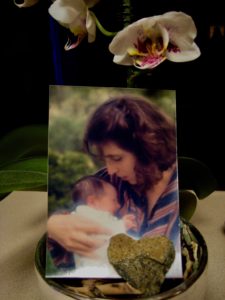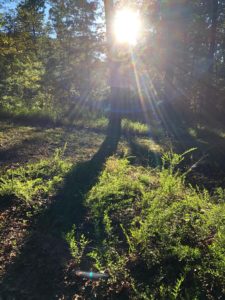
– Photo by Jan Ketchel
Several months ago, I found out that the man who had abused me during my childhood had died. A few weeks after his death he appeared in a dream.
Putting his arm over my shoulder, he hugged me gently and spoke some kind words. In the dream he was very loving, not at all how I knew him in real life. It was a little disconcerting to say the least. I was not sure what to make of it.
Then again, two months after that, he came in another dream. I am lucid, fully conscious of dreaming in this dream, fully aware of being with him. I have no reaction to being in his presence; I am as calm as calm can be.
We sit opposite each other, foreheads almost touching, looking directly into each other’s eyes. Once again he is kind, concerned, as he states: “SHE says I did this to you,” and he glances to the side, as if looking at someone standing offstage.
Then, he gestures with his hands and a scene from my childhood appears between us, suspended in midair. It’s like looking at an old movie; in the scene he is abusing me. I nod at him, and say, “Yes, it’s true, you did that to me.” I have no reaction; I am perfectly calm as I see the scene play out and as I tell him the truth, that it actually happened.
Again, he repeats, “SHE says I did this to you,” and once again he gestures with his hands, putting them together as if praying and then pulling them apart, and as he pulls them apart another scene of him abusing me materializes.
“Did I do this to you?” he asks, incredulous.
Again, I nod at him, and say, “Yes, it’s true, you did that to me.”
We sit like this, head to head, for a long time as he repeats, over and over again, “SHE said I did this to you,” glancing over his right shoulder toward the SHE whom I feel standing off to the side, observing, as he materializes yet another scene of him abusing me and which I acknowledge as truth. Again, I have no reaction to any of the traumatic scenes playing out between us. I do not wish to blame or shame him. I am perfectly calm and emotionally neutral.
As this plays out I realize that he has no memory of the life he has just lived, that he can’t remember anything that he had done. It appears that he’s going through a life review with SHE as his guide. He has total amnesia and appears flabbergasted every time I tell him that he did all those things to me. It’s as if he’s hearing about it for the first time.
We look squarely into each other’s eyes and I can see that he’s being honest, he simply does not remember; he’s a clean slate, with no memory whatsoever.
At first, I think I’m being challenged to recant my own life story, but then I see that this is not the case, that SHE is his teacher, helping him to recapitulate the life just lived. SHE appears to know everything about him. I sense that SHE brought us together, to help him remember.
I intuit that everyone must recapitulate at death, that all memory of the life just lived is lost and must be brought back into consciousness so that all can be reviewed and reconciled with in order to move on into a higher plane of existence.
The setting of the dream is desert-like, empty except for some low adobe buildings in the distance, which I intuit are spartan living quarters. Low dry brush, desert grasses and sand stretch in every direction as far as the eye can see. There’s a kind of dull light, not dark, not light, just kind of overcast, the temperature neither hot nor cold but comfortable.
After going through countless scenarios of the abuse he inflicted on me, we get up and he takes me over to a pile of long scrolls of tapestry lying on the ground, the frameworks upon which he must weave his just-lived life as he recapitulates, creating a large tapestry to study, learn from and evolve from.
“SHE tells me that everyone does it when they come over,” he says, and he suggests that I pick one up and create a tapestry too, but I tell him that I don’t need to do that, that I’ve already done it.
“I already did a recapitulation,” I say, “my books, you know.”
He nods, but I sense that he still doesn’t understand that he did all the things he’s been told he did. He’s an empty vessel, unable to grasp, totally clueless, but he understands from SHE that it’s his job now to remember and to weave the tapestry. It will take him a long time, he says, because he can’t remember a darned thing. He shakes his head in disbelief.
I sense how low his energy is, as if he’s depressed, stunned or traumatized by what he’s learning about himself. It feels as if he’s being slowly eased into knowing a little at a time about who he had been, not the kindly man I met in the first dream, nor who he appears to be now but a cold-hearted pedophile.
How interesting, I think, that his overall personality is gentle and kindly, that though he was a pedophile in his last life that may not be who he actually is in his spirit body, but that it was a persona he wore in order to learn something or challenge himself with.
Later, I tell him that I love him because I know that he is genuinely trying to fathom what he had done, and I sense that the work he has to do on himself is being attended to with diligence and honesty, that he really wants to get to the truth. And I can love him for that.
Recapitulation, I tell him, is the key to advancement. He nods when I say this, still muttering that he just can’t believe what he’s been told he did.
As I leave, I see him hanging up the framework, preparing to begin the job of building the tapestry with the truth. I am happy to have helped him verify that truth.
As I walk away, I am perfectly calm and at peace, knowing that indeed my own recapitulation of my abusive childhood is done. There will still be other things to recapitulate I’m sure, but that at least is fully done.
Sending love,
Jan
J. E. Ketchel, Author of The Recapitulation Diaries and All The Gifts You Are Given



